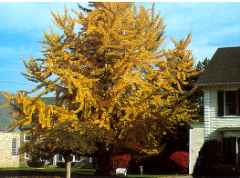 Ginkgo
biloba…The Memory Tree
Ginkgo
biloba…The Memory Tree
 Ginkgo
biloba…The Memory Tree
Ginkgo
biloba…The Memory Tree
One of the more interesting trees we plant is the Ginkgo biloba, most currently recognized for its herbal effects. All of the drug and grocery stores now tout Ginkgo derivatives as the memory enhancement remedy. I stated sometime back, we even have Gingko biloba dog chews. If I can't remember things, then neither can my dog. Pardon me while I scratch a bit.
From a landscaping standpoint, the Ginkgo tree is a stately tree that grows somewhat upright and columnar. The tree tends to be somewhat open in its growth habit prior to full maturity lending itself to an intriguing silhouette. The tree is very adaptable to many conditions including urban street environments. The Gingko leaf is an attractive light green fan with two lobes, thus the name “biloba”. The fall color is a beautiful golden yellow.
The biology of the Gingko is interesting in that this Asian native is one of the oldest trees in the world, often called a “living fossil”. The Gingko is thought to have been in existence for about 150 million years, co-mingling with the dinosaurs in the Jurassic period. While the tree was quite common worldwide, its population has dwindled to near extinction, with the European and North American population disappearing from the wild. The ferns are considered to be the earliest of the more sophisticated vascular plants, but the Ginkgo is probably the oldest vascular plant of such massive structure. The Gingko is in a “Class” (Class Ginkgoae) of its own, unlike the broad class of flowering Angiosperms. The Ginkgo stands alone in its heritage.
Gingko is a Gymnosperm, meaning that it has male and female plants. Angiosperms have male and female parts in the flowering of the same plant. The leaves are used for the extract used to produce herbal remedies. The Ginkgo extract is believed to help with arterial problems, which explains the effectiveness as a memory loss aid. Any negative commentary about the Gingko can be attributed to the fruit of the female Ginkgo. It takes a good 20 years for the Gingko to develop fruit but it is known to have an odor similar to dog manure. The fruit of the Gingko is a favorite food in the Orient. Kim chi and sushi! To each their own. Only in 2000 did I encounter the Gingko fruit and, let me tell you, its odor is dog manure magnified!
Ginkgo is slow to grow
in the early stages, thus they cost a bit more than common trees such as
maple and dogwood. Named and grafted varieties are male trees that
will never fruit. Beware of unnamed varieties of Ginkgo, as they
are not sexed and you have a 50/50 chance of acquiring a female.
It will be 20 years before your Ginkgo fruits, so planting a female could
be part of your personal legacy. Until next week.
Andy Lynn